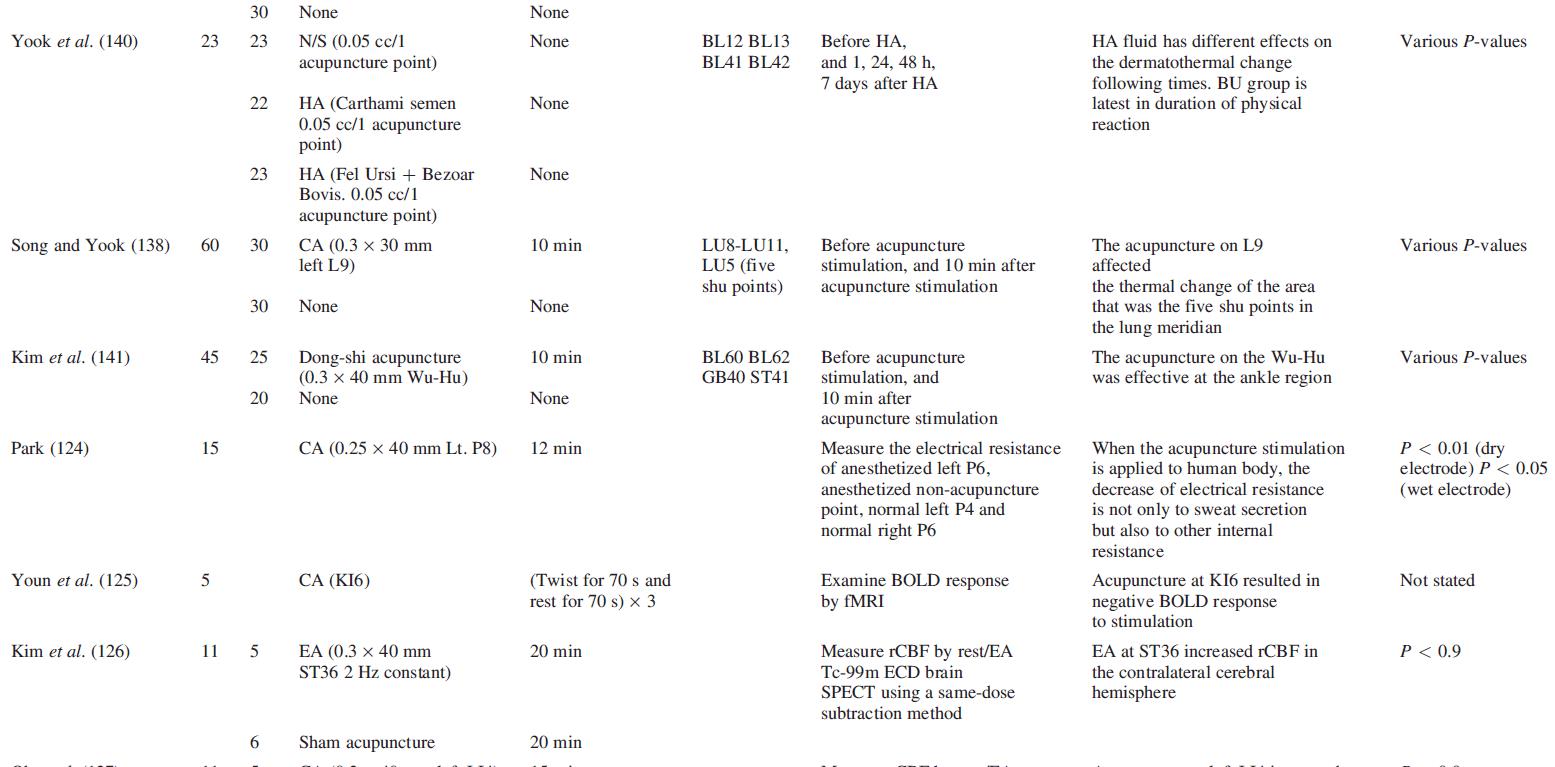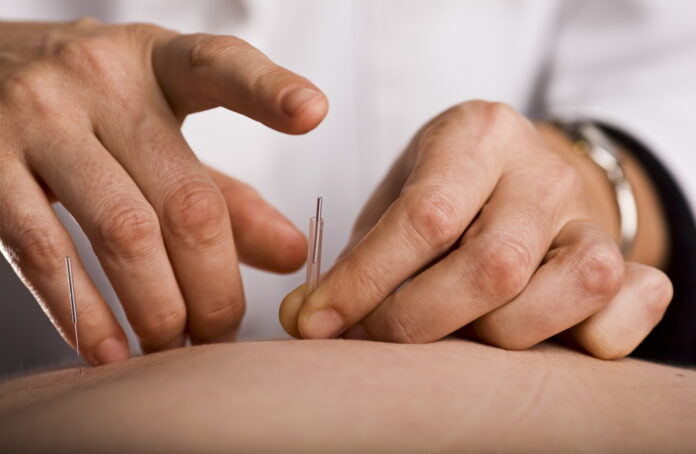By Yong-Suk Kim1, Hyungjoon Jun1, Younbyoung Chae2, Hi-Joon Park3, Bong Hyun Kim4, Il-Moo Chang4, Sung-keel Kang5 and Hye-Jung Lee2
- 1Department of Acupuncture and Moxibustion, College of Oriental Medicine, Kangnam Korean Hospital,
- 2Department of Oriental Medical Science, Graduate School of East-West Medical Science,
- 3Department of Meridian and Acupuncture, College of Korean Medicine, Kyung Hee University,
- 4Natural Products Research Institute, Seoul National University, Seoul, South Korea
- 5Department of Acupuncture and Moxibustion, College of Oriental Medicine, Kyung Hee University, South Korea
Acupuncture for Human Study
Acupuncture stimulation significantly decreased electrical resistance under the adiaphoresis, suggesting that the decrease of electrical resistance is caused not only by sweat secretion but also by other internal resistance (124). Youn et al. (125) reported a strong correlation between acupuncture at KI6 and cortical activation in the motor-related region of the human brain by using fMRI. Acupuncture at LI4 in the left hand increased regional CBF (rCBF) in the right parietal lobe, middle temporal gyrus and inferior occipital lobe, and electric acupuncture at ST36 on the right side increased rCBF in the left temporal lobe, the inferior frontal lobe and cerebellar hemisphere using single photon emission computed tomography (126, 127). It was shown that acupuncture at LI4 and LV3 could ipsilaterally enlarge a blind spot map (128).
Several studies were performed to examine if acupuncture at LI4 changed skin temperature in the LI4 area of the hand, LI11
area of the arm, LI20 area of the face and ST25 area of the abdomen by using DITI (129–135). It was also examined to see whether the alteration of acupuncture manipulation method could change the temperature in these regions of the body (136, 137). Other studies were performed to investigate the effects of acupuncture at LU9 by thermal change in the five shu points or LU9 and LU1 areas of lung meridian (138, 139). Yook et al. (140) examined whether HA at BL12, BL13, BL41 and BL42 could affect local thermal change by using DITI. Kim et al. (141) examined whether acupuncture at the WuHu acupoint could affect thermal change in the ankle region (Table 21).




Discussion
A large number of clinical studies have used acupuncture; electric acupuncture, moxibustion and other traditional therapies to target a relatively broad range of medical problems, primarily pain and stroke. Moreover, acupuncture has been widely used for treatment of facial palsy, obesity, hypertension, nausea and vomiting, and many other diseases. However, as mentioned in the beginning of this report, the studies had various weaknesses such as inadequate sample size, inappropriate control treatment, inadequate follow-up, inadequate control of non-specific effects, inadequate reporting of side effects and a few studies’ failure to replicate results. These concerns make it difficult to draw clear conclusions about efficacy in most areas where acupuncture has been tested.
A number of systematic reviews on acupuncture for specific conditions have recently been published, including an extensive systematic review on chronic pain, with a far reaching search strategy and a way of scoring trial methodology (142). Recently, the best evidence synthesis review showed that there was only limited evidence that acupuncture is more effective than no treatment (waiting list) and inconclusive evidence that acupuncture is more effective than inert placebo, sham acupuncture or standard medical care (143). In addition, the evidence of rigorous randomized controlled trials showed that there was no compelling evidence to show that acupuncture is effective in stroke rehabilitation (144). Yet, as clinicians who treat patients with acupuncture, we have success in these treatments where no efficacy is found. This is due to a complex set of problems at the heart of which is the establishment of a standard for the treatment of the control group. This article is not a systematic review; rather it is an overview of the clinical trials, presented in the hopes of introducing overall information about clinical studies in Korea to the English-speaking world.
This review describes a number of clinical studies that were performed to compare the therapeutic effects of different kinds of acupuncture under certain conditions. Conventional acupuncture was compared with electric acupuncture, auricular acupuncture, BVA and manipulation. These comparative studies of different kinds of acupuncture are required in order to proceed with the most adequate method in the future. Since more than two therapies were simultaneously performed to treat the disorders in some studies, it is not likely to demonstrate the efficacy of pure acupuncture apart from other treatments.
For instance, given that both acupuncture and auricular acupuncture were effective to treat tension-type headache patients, it is impossible to clarify the extent of the therapeutic benefit of acupuncture. Therefore, in order to investigate the therapeutic benefits of acupuncture, it is necessary to establish a group treated by acupuncture alone. From the above clinical studies, it is possible to summarize the originality of Korean acupuncture by describing both of its characteristic approaches—individualized and practical.
Firstly, a number of clinical studies in Korea have shown the benefits of individualized acupuncture treatment, such as Saam, Taegeuk or Eight constitutions acupuncture (35). Patel et al. (145) noted that individualized treatments significantly favored acupuncture, whereas formulaic approaches, in which all the patients received the same treatment, showed no significant
difference. However, in order to demonstrate its superiority, more rigorous and well-designed randomized controlled clinical trials are urgently needed. Secondly, HA-like BVA have been used to treat a variety of painful conditions. HA is a new method of acupuncture where distilled herbal decoction is extracted and purified to be administered to an acupuncture point for stimulation. HA simultaneously exerts pharmacological actions from a bioactive compound isolated from herbal medicine and mechanical actions from acupuncture stimulation. The Korean medical world considers HA as a promising therapeutic method for various diseases (84,140).
An individualized approach based on constitutional energy traits have been widely applied to a number of clinical trials in Korean medicine. HA have also been developed as a new therapeutic modality using integrated and practical approaches. Korean acupuncture in its own way is making a contribution to the emerging need for individualized and integrated approaches to acupuncture. In closing, we stress the need for randomized controlled studies and express our hope that this view into Korean traditional medical practice will lead to metaanalysis in the near future.
References
124. Park KM. Influence of acupuncture stimulation on electrical resistance under adiaphoresis induced by regional anaesthesia. J Kor Acu Mox Soc 2000;17:130–8.
125. Youn JH, Hwang MS, Bae GT, Lee SH, Lee SD, Jang JH, et al. The new finding on BOLD response of motor acupoint KI6 by fMRI. J Kor Acu Mox Soc 2001;18:5.
126. Kim ID, Oh HH, Song HC, Bom HS, Byun JY, Ahn SG. The nuclear medical study on the effect of ST36 electroacupuncture on cerebral blood flow. J Kor Acu Mox Soc 2001;18:18–26.
127. Oh HH, Byun JY, Kim ID, Ahn SG, Mun HC, Hwang WJ, et al. The nuclear medical study on the effect of LI4 acupuncture on cerebral blood flow. J Kor Acu Mox Soc 2001;18:46–54.
128. Woo YM, Nam Y. The practical study of the contralateral therapeutic theory in acupuncture approach about the changes in the blind spot mapping pre and post acupuncture. J Oriental Med Surg Ophthalmol Otolaryngol 2000;13:200–10.
129. Lee SH, Lee JD, Lee YH. Thermographic study on the effects of acupuncture at Hapkok (LI4) in normal cases. J Kor Acu Mox Soc 1995;12:49–64.
130. Sohn IC, Kim DM, Kim HJ, Lee HS, Kim KS. Effects on the thermal changes of Hap-Kok (LI4) and Chun-Choo (ST25) following acupuncture on Hap-Kok (LI4) in man. J Kor Acu Mox Soc 1998;19: 66–88.
131. Han MC, Chung HC, Koo ST, Ahn SH, Kim KS, Sohn IC. Effects of acupuncture at left Hap-kok (LI4) on the skin temperature changes of Young-Hyang (LI20) area. J Kor Acu Mox Soc 1999;16:57–68.
132. Song JS, An SH, Kim JH, Kim KS, Sohn IC. Effects on the thermal changes of Kok-Chi (LI4) and Yong-Hyang (LI20) following acupuncture on Hap-Kok (LI4) in man. J Kor Acu Mox Soc 1998;19:271–95.
133. Han MJ, Chung HC, Koo ST, Ahn SH, Kim KS, Sohn IC. Effects of acupuncture at left Hap-Kok (LI4) on the skin temperature changes of Young-Hyang (LI20) area. J Kor Acu Mox Soc 1999;16:57–68.
134. Hwang JH, Ahn SH, Kim KS, Sohn IC. Effects of acupuncture at Hap-Kok (LI4) on the thermal changes of abdominal surface in man. J Kor Acu Mox Soc 1999;16:445–72.
135. Yun JH, Hwang CY, Lim KS. Effects on the thermal changes of the face follow electroacupuncture on Hapkok (LI4) and Samgan (LI3). J Oriental Med Surg Ophthalmol Otolaryngol 1999;12:222–47.
136. Lee SW, Lee JH, Song BY, Yook TH. The effect on the thermal changes of an acupuncture point area with the Young-Su-Bo-Sa acupuncture stimulation. J Kor Acu Mox Soc 2001;18:161–74.
137. Song BY, Sohn IC, Kim KS. Effects on the thermal changes of the corresponding meridian points following the left or right rotary acupuncture stimulation. J Kor Acu Mox Soc 1999;16:385–402.
138. Song BY, Yook TH. Effect of the thermal changes of Five-shu-points of the lung meridian with acupuncture stimulation on Taeyon (L9). J Kor Acu Mox Soc 2000;17:219–32.
139. Kim YH, Song BY, Yook TH. Effects of the thermal changes of the Taeyon (L9) and the Chungbu (L1) area following acupuncture stimulation on Taeyon (L9) in man. J Kor Acu Mox Soc 2001;18: 77–91.
140. Yook TH, Song BY, Shim MS, Kim BH, Park JJ, Yun JH. Effects on the local thermal change following herbal acupuncture on DITI. J Kor Acu Mox Soc 2000;17:57–68.
141. Kim HJ, Byun JY, Ahn SG, Lee GM, Park YH, Kim KS. Effects on the thermal changes of the ankle region following acupuncture on Wu-hu. J Kor Acu Mox Soc 2001;18:40–9.
142. ter Riet G, Kleijnen J, Knipschild P. Acupuncture and chronic pain: a criteria-based meta-analysis. J Clin Epidemiol 1990;43:1191–9.
143. Ezzo J, Berman B, Hadhazy V, Jadad A, Lao L, Singh B. Is acupuncture effective for the treatment of chronic pain? A systematic review. Pain 2000;86:217–25.
144. Park J, Hopwood V, White A, Ernst E. Effectiveness of acupuncture for stroke: a systematic review. J Neurol 2001;248:558–63.
145. Patel M, Gutzwiller F, Paccaud F, Marazzi A. A meta-analysis of acupuncture for chronic pain. Int J Epidemiol 1989;18:900–6.

































